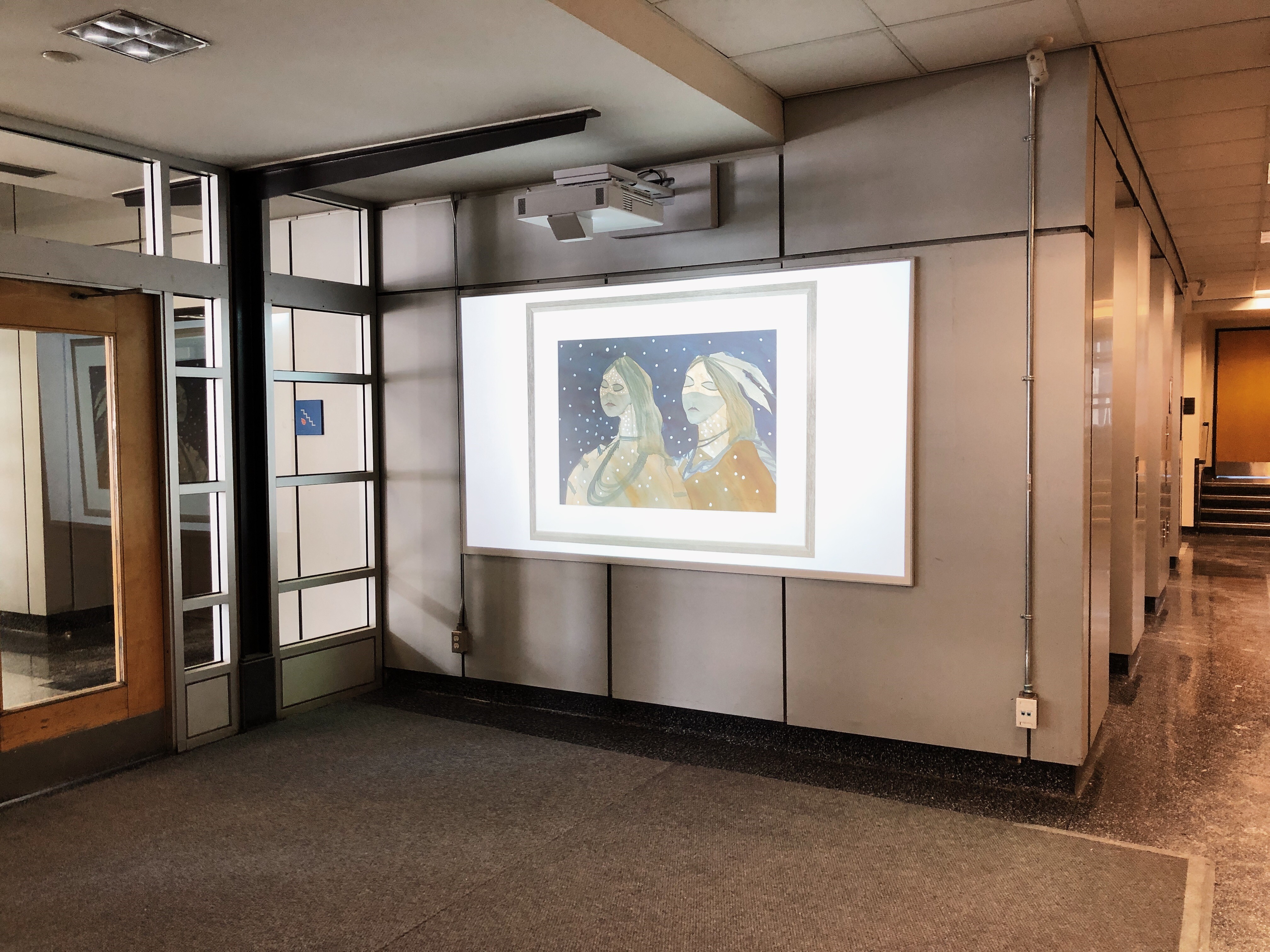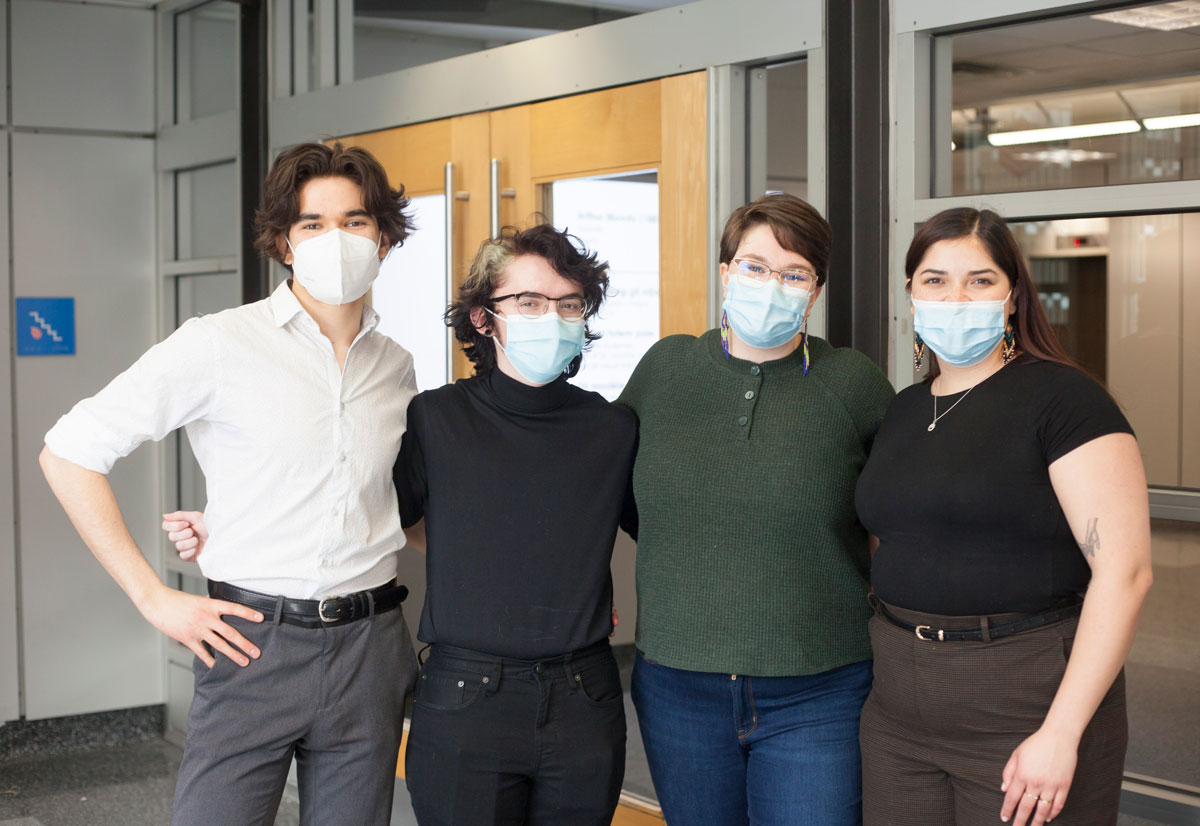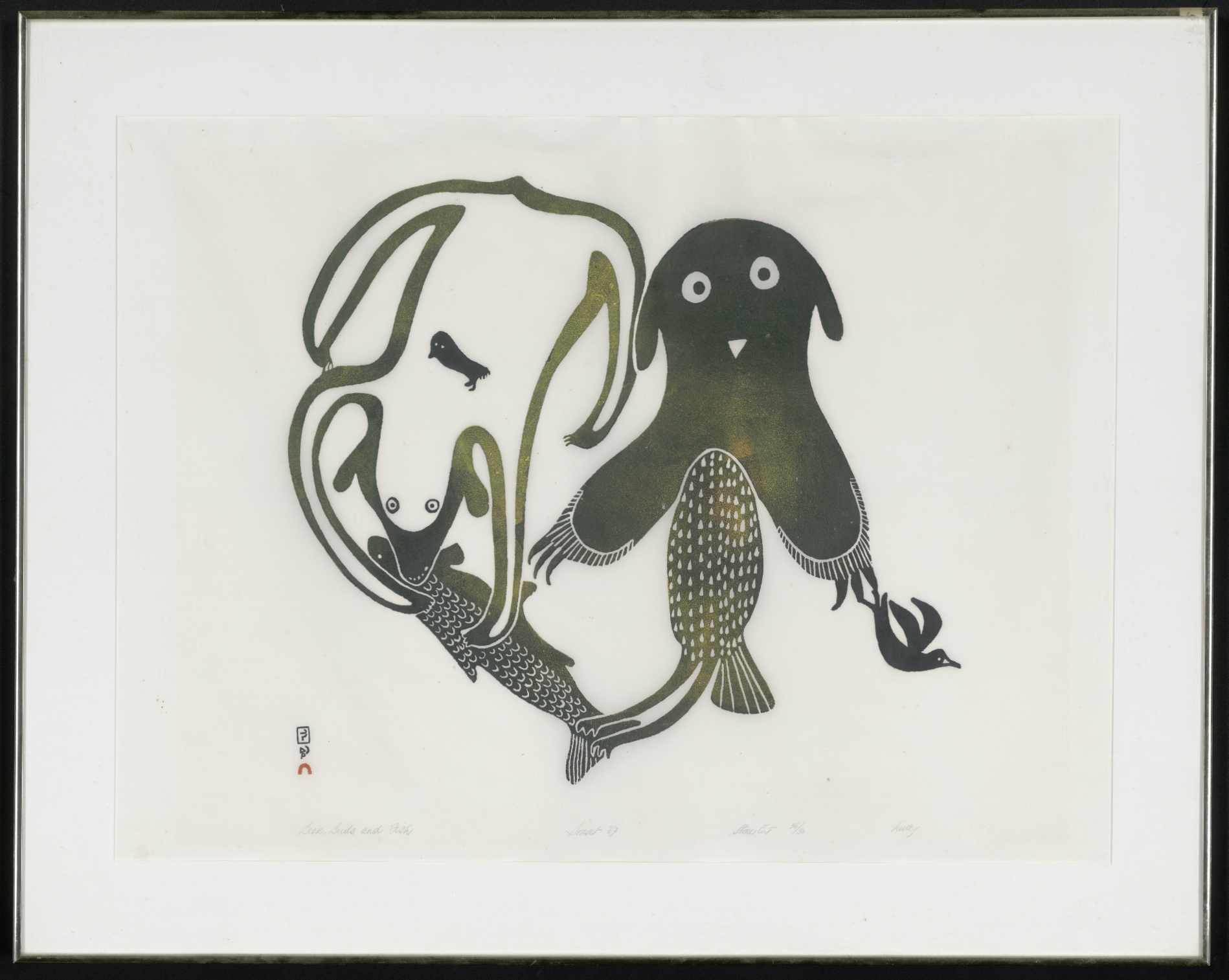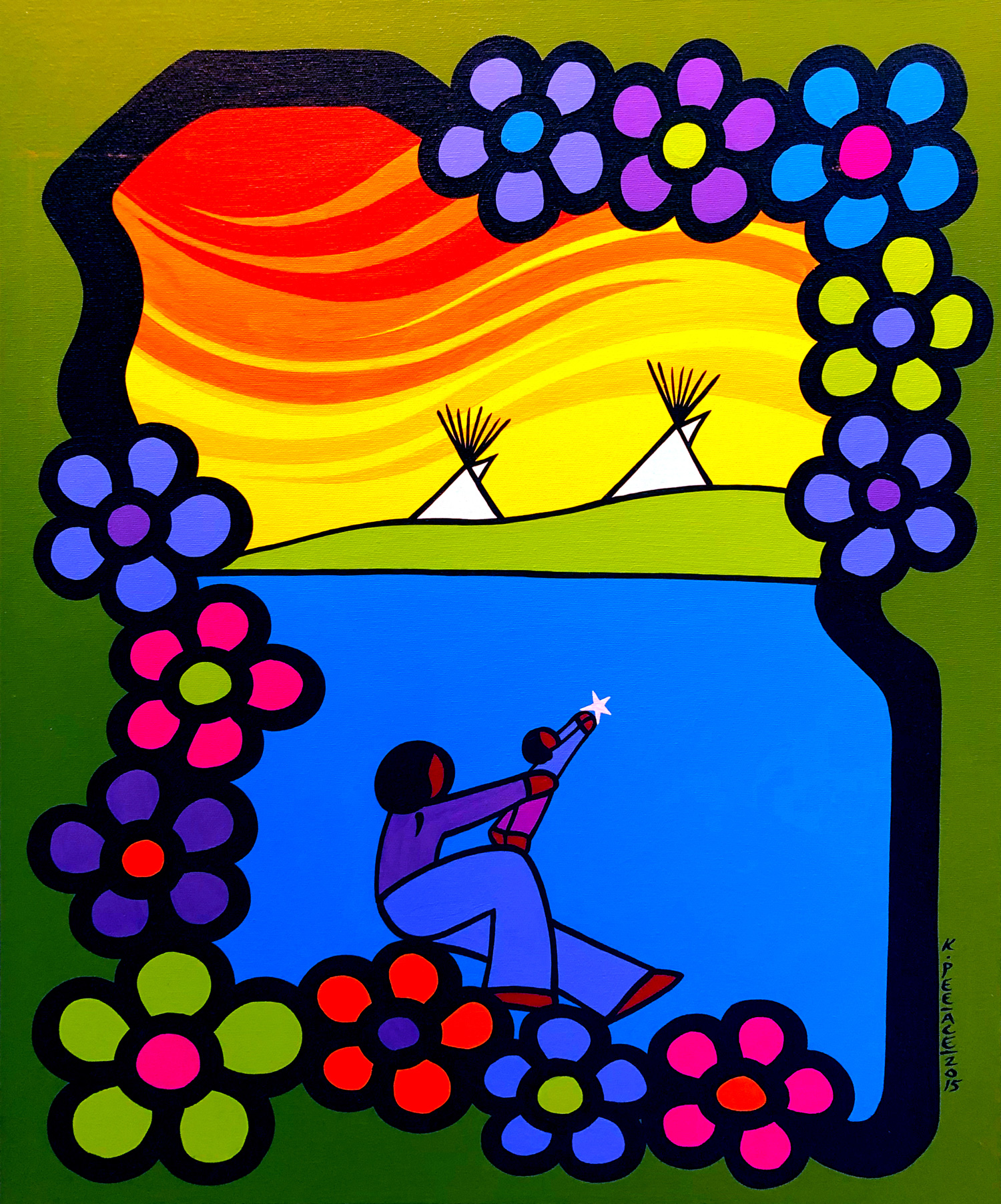Projections is a pilot digital exhibition aiming to strengthen the inclusion of underrepresented groups within the Faculty of Engineering through art, as well as to increase access to art for the entire McGill community.
Interested in taking part in future exhibits? eidea [at] mcgill.ca (Email us here)
Projections: Kwe
Projections: Kwe is the inaugural exhibit in the Projections series. The project was initiated by the Engineering Undergraduate Society’s Indigenous Inclusion Committee (IIC) with the hopes of increasing visibility, representation, and inclusion of Indigenous students and cultures in the Faculty of Engineering, and developed in collaboration with the Faculty of Engineering’s Dean’s office, the Provost’s Indigenous Initiatives Office, and McGill’s Visual Arts Collection.
The exhibit features 30 artworks from a variety of First Nations, Inuit and Métis communities, curated by the Indigenous Inclusion Committee from McGill's Visual Arts Collection. It is the first exhibit of its kind at McGill.
In concert with Projections: Kwe, the Faculty of Engineering has installed two permanent artworks by Benjamin Chee Chee, Afternoon Flight and Friends, on the first floor of the McConnell Engineering Building.

Curatorial Statement
Curatorial Statement in Mohawk
Ratinonhsakétskwas, ratiráhstha tsi ní:ioht tsi akanonhsakétskwen, tánon ratirihwahserón:nis akanakerahserá:ien nikaio’tenhserò:tens A’nowarè:ke né:’e Onkwehón:we rononhontsà:ke ronterihwahtentià:tha.
Ohstonterì:tshera kahiá:ton aka’shátsteke, aontaiako’nikonhratihéntho, tánon enwahtétia’te tsi tenhatihtharónnion ne Faculty of Engineering, sok ki’ enwá:ton ne ronterihwaiénhstha tánon rotiio’ténion ahonnonhtonnión:ko ne nahò:ten enkakarónnia’te ne raotiio’ténhsera, iah kwah nek ne tsi kanáthen, nek tsi ò:ni ne Onkwehón:we raotirihwà:ke ohontsakwé:kon ne Koráhne
Ne tekawén:nake “Onkwehón:we Raononhóntsa” né:’e tsi ní:ioht tsi aieién:tere’ne tsi Koráhne ohóntsa tehotihsnié:’on tánon ratinakeráhkhwa ne Onkwehón:we ne tewen’niawe’éhseron niiohserá:ke, arenhátien tsi nikawén:nake róntstha ne kakoráhsera. Ne kenh ní:ioht, akwé:kon ne ohóntsia A’nowarè:ke Onkwehón:we raoná:wen, iah kwah nek ne ronatkà:wen (ceded) tóka’ni iah tehonatkà:wen (unceded) ohóntsa, tánon ò:ni, akwé:kon kaio’tenhsera’shón:’a A’nowarè:ke, tóka’ ratinonhsakétskwas, ratiráhstha tsi ní:ioht tsi enwatenonhsón:ni, ratirihwahserón:ni akanakerahserá:ien, tóka’ni ionterihwaienhstáhkhwa aoio’ténhsera tánon kanonhsó:ton, tsi ní:ioht ne ionterihwaienhstahkhwa’kó:wa, Onkwehón:we rononhontsà:ke kanonhsó:ton.
Nek tsi, iotkà:te iah tekaienteré:’en kí:ken tsi niiá:kon kí:ken nihotiio’tenhserò:ten, arenhátien tsi kwah í:ken tsi rotikaronnià:tha ne Onkwehón:we tsi rononhnhétie, ne ò:ni ne ohóntsa tánon iah ón:kwe té: ne ne kontì:teron. Tsi rotiio’tátie ahatikówanahte tsi niió:ken ne Onkwehonwehnéha tsi nón:we ne Faculty of Engineering, tánon tsi ratirihwáhsere ne McGill aó:wen tékeni tewen’niá:wer niiohserá:ke iorihwà:ke ne Onkwehón:we tsi tehatihwihshátste tánon rotiianerahstén:nis, ne Indigenous Inclusion Committee (IIC) tahontáhsawen tánon wahatinenhrì:ne tsi onhténtia’te tsi ronterihwatsteríhstha, Projections: Kwe.
Tsi rotiia’tarò:ron ne Onkwehón:we ronterihwaiénhstha tetsarónhkwen otióhkwakon nok a’é:ren nón:we ne Faculty of Engineering, ne IIC wahontia’tarò:roke ne ahatirá:ko ne nahò:ten enwatena’tón:ni ón:wa wenhniserá:te. IIC wahón:nehre tsi aonhá:’a tiorihowá:nen ne ahatirá:ko nia’tekaio’tenhserá:ke ne ne nia’teiohtánion tsi ronón:ni, né:ne ronón:ni tsi niiá:kon nia’té:kon nikanakerahserá:ke Onkwehón:we, Othore’kehró:non nok Métis nithoné:non. Ne kí:ken sewahén:ton, ne karihwaráhston, ne karò:ron ne karahstánion, tsi ní:ioht ne Norval Morrisseau raó:wen Shaman Surrounded by Ancestral Spirit Totem (1977), kaia’tarónnion, tsi ní:ioht ne Nadia Myre akó:wen Meditations on Red (2013), tánon kahkaratáhkwen, tsi ní:ioht ne Tytoosie Tunillie raó:wen Sedna. Kí:ken nihotiié:ren ne ki’ ahatirihwá:kenhste tsi nia’té:kon nihotirihò:tens ne Onkwehón:we ohontsakwé:kon ne A’nowarè:ke, ne ò:ni ne Onkwehonwehnéha rononniánions tsi na’teiotkanón:ni nok na’teiohswáhthe.
IIC ronatià:tare ronhská:neks tsi rotikwatákwen ne Projections: Kwe kanónhskon ne McConnell Engineering kanónhsote né:’e enkarihwahní:rate tsi Onkwehón:we ne ne ronterihwaiénhstha ne Faculty of Engineering sénha enhónttoke tsi sénha enhatikwé:konke, ne kwah tsi ió:ken tánon kaienteré:’en, tánon tsi iah tehononkwehón:we tenhatí:ta’ne nok ahonnonhtónnionhwe tsi nenwatkahtho’tshero’ténhake tóka’ sénha ahatikwé:konke, ahonaterihón:take, tánon tahatiienásheke, tánon tsi nenkaié:ren ne tho nonkwá:ti nahontié:ra’te ón:wa wenhniserá:te.
Indigenous Inclusion Committee
ronterihwahsteríhstha ne Projections: Kwe
Curatorial Statement in English
Engineering, architecture, and urban planning projects in North America take place on Native land.
The sentence is written to be strong, to provoke thoughts, and to initiate conversation within the Faculty of Engineering, so that students and staff can think about the impacts of their projects, not just for urban areas, but also for Indigenous Peoples everywhere in Canada.
The phrase “Native land” is a way of acknowledging that the land in Canada has been taken care of and inhabited by Indigenous Peoples for centuries, regardless of the legal terminology that colonial institutions such as governments may use to describe them. In this way, all land on Turtle Island is Native land, not just ceded or unceded territory, and moreover, all projects on Turtle island, whether they be engineering, architecture, urban planning, or even academic projects and institutions, like universities, are located on Native land.
However, this often goes unacknowledged within the field at large, despite these projects having profound effects on the lives of Indigenous Peoples, as well as the land and non-human beings who reside within. In an effort to increase the visibility of Indigeneity within the Faculty of Engineering, and in keeping with McGill’s bicentennial themes of Indigenous resilience and excellence, the Indigenous Inclusion Committee (IIC) began and led the establishment of the curation, Projections: Kwe.
As a collective of Indigenous students both within and outside of the Faculty of Engineering, the IIC came together to select the pieces of art that you see on display today. Of the utmost importance to the IIC was choosing works from different creative mediums, made by artists that hail from a variety of First Nations, Inuit and Métis communities. Featured before you, for example, are a collection of paintings, such as Norval Morrisseau’s Shaman Surrounded by Ancestral Spirit Totem (1977), photographs, like those of Nadia Myre’s Meditations on Red (2013), and sculptures, like Tytoosie Tunnillie’s Sedna. This was done to highlight the long-standing diversity of Indigenous Peoples across Turtle Island, as well as the rich and vibrant nature of Indigenous creativity.
Members of the IIC hope that the establishment of Projections: Kwe within the McConnell Engineering building will both ensure that Indigenous students already in the Faculty of Engineering feel more included, particularly in terms of visibility and acknowledgment, and that non-Indigenous students will take a moment to imagine what a more inclusive, responsible, and cooperative field can look like, and what steps can be taken to move in such a direction today.
Indigenous Inclusion Committee
Curators of the Projections: Kwe exhibition
Curatorial Statement in French
En Amérique du Nord, les projets de génie, d’architecture et d’urbanisme sont réalisés en territoire autochtone.
Cette phrase percutante vise à provoquer la réflexion et à amorcer un dialogue à la Faculté de génie. Les étudiants et les membres du personnel sont ainsi appelés à réfléchir aux répercussions de leurs projets, non seulement sur les zones urbaines, mais aussi sur la réalité des Autochtones de partout au Canada.
Par le terme « territoire autochtone », nous prenons nos distances avec la terminologie juridique établie par les institutions coloniales, notamment les gouvernements, et mettons en évidence le fait que, pendant des siècles, les Autochtones ont habité les terres du Canada et en ont pris soin. Ainsi, les terres de l’Île de la Tortue sont bien plus que des terres cédées ou non cédées; ensemble, elles forment un territoire autochtone. Qui plus est, tous les projets réalisés sur l’Île de la Tortue, qu’il s’agisse d’ouvrages de génie, d’architecture ou d’urbanisme, ou même de projets ou d’établissements d’enseignement, comme des universités, se trouvent en territoire autochtone.
Pourtant, cette réalité est souvent passée sous silence, même si les projets ont de profondes répercussions sur la vie des Autochtones, ainsi que sur les terres et les êtres vivants qui les peuplent. C’est dans une volonté d’accroître la visibilité de l’identité autochtone à la Faculté de génie, et inspiré par les thèmes de la résilience et de l’excellence des peuples autochtones du Bicentenaire de l’Université McGill, que le Comité de l’inclusion autochtone a monté l’exposition Projections: Kwe.
Le Comité de l’inclusion autochtone, formé d’étudiants autochtones de la Faculté de génie et d’autres facultés, s’est réuni pour sélectionner les oeuvres d’art que vous pouvez admirer aujourd’hui. Le Comité s’est fait un point d’honneur de choisir des oeuvres réalisées dans différents médiums par des artistes provenant de diverses communautés des Premières Nations, des Inuits et des Métis. Vous découvrirez des peintures, dont Shaman Surrounded by Ancestral Spirit Totem (1977) de Norval Morrisseau, des photographies, notamment Meditations on Red (2013) de Nadia Myre, et des sculptures, dont Sedna de Tytoosie Tunnillie. Par ses choix, le Comité souhaitait mettre en lumière la diversité qui caractérise depuis longtemps les peuples autochtones de l’Île de la Tortue, ainsi que la richesse et le dynamisme de la créativité autochtone.
En montant l’exposition Projections: Kwe dans le Pavillon de génie McConnell, les membres du Comité de l’inclusion autochtone souhaitaient renforcer, par la visibilité et la reconnaissance, le sentiment d’inclusion chez les étudiants autochtones de la Faculté de génie et voulaient inciter les étudiants allochtones à imaginer un milieu plus inclusif et plus solidaire, et à réfléchir aux mesures à prendre pour s’engager dans cette voie.
Le Comité de l’inclusion autochtone
commissaire de l’exposition Projections: Kwe
Visit the exhibit space
Projections: Kwe is open to the public. We invite all to come view the exhibit and engage with the stories behind each work.
Location: McConnell Engineering Building Lobby (3480 University Street)
Launch
Acknowledgments
Projections: Kwe was realized by means of an inter-university collaboration between the Indigenous Inclusion Committee, the Faculty of Engineering Dean’s Office, the Provost’s Indigenous Initiatives Office, and McGill’s Visual Arts Collection. The project would not have been possible without the efforts of many people within these units and across McGill.
Many thanks to Isabelle Prévost-Aubin (Métis Nation), Dallas Karonhia'no:ron Canady-Binette (Kanesatake'ro:non, Kanien'keha:ka), Kayleigh Spencer (James Bay Cree), Jocelyne Couture (Métis Nation of Ontario), and Jonas Henderson (Kalaaleq) from the Indigenous Inclusion Committee; Dicki Chhoyang from the Indigenous Initiatives Office, Dana-Marie Williams (Mi'kmaq/Pottawatomi) from First Peoples' House and Carole Brazeau (Algonquin Anishinabe); Wendy Owens, Michelle Macleod, Hannah Deskin, Catherine Galbraith, and Greg Houston from the Visual Arts Collection, a part of McGill’s Rare and Special Collections, Osler, Art and Archives (ROAAr); and Chidinma Offoh-Robert, Antonella Fratino, Shannon Gao, and Leela Baldeo from the Faculty of Engineering for working together to make Projections: Kwe a reality.
Thanks also to Thomasina Phillips (Mohawk Nation) from First Peoples’ House and Stew McCombie and Jonathan Roy from Multimedia for their help with the launch event, as well as Nigel Ayoung-Chee, Shawn McCollum, Sara Di Stefano, Eric Binette, Martin Lemieux, and Andre Fillion for their IT support.
Special thanks to Elder Geraldine Standup (Mohawk Nation) and Dayna Danger (Métis/Saulteaux/Polish), McGill’s Mellon Indigenous Artist in Residence supported through ISCEI, for participating in the launch.
Kwe title design by Dallas Karonhia'no:ron Canady-Binette. Exhibition slide layout and design by Shannon Gao and Michelle Macleod. Photos and video featured in launch video taken by Jonas Henderson, Antonella Fratino, and Michelle Macleod.


